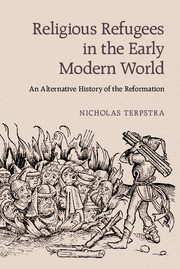5 - Re-Forming the Body: The World the Refugees Made
Published online by Cambridge University Press: 05 August 2015
Summary
The drive to protect, purge, and purify radically reshaped European society over the course of the early modern period. We can see its effects in politics, the economy, migration, law, and social life, as well as in religious institutions, rituals, and thought. It is striking that definitions become sharper and differences between religious communities more bitter over this period. The number of religious exiles and refugees grows throughout the seventeenth century, and purgative spasms recur in the eighteenth century when we might think that Europe had put all of that behind it as religious faith supposedly began to wane. Instead, Louis XV launched a crusade against Huguenots in the Cevennes Mountains in 1702, the archbishop of Salzburg forced 20,000 Lutherans into exile in Prussia in 1732, and the British loaded more than 11,000 Catholic Acadians onto boats and shipped them overseas in the later 1750s. Religious purgation was alive and well in the Age of Reason.
In order to understand why, we need to look more closely at how the innovations and actions of the fifteenth and sixteenth centuries became the norms and customs of the seventeenth. For that we need to look at how Christians of all confessions, and Jews and Muslims too, began rethinking and reforming the tools, personnel, spaces, and creative life of their religious communities. Refugees and exiles were frequently the most committed and best connected members of their religious communities. They were authors, artists, lawyers, teachers, and bureaucrats, and they worked directly and indirectly for change using the most advanced means available. New forms of technology, particularly printing, allowed texts and images to be used more creatively. New schools, curriculum, and pedagogy coming out of the humanist movement fed a drive to improve the training and raise the professional standards for clergy. New ideas about how communities should relate to God or conduct ritual life changed the spaces, furnishings, and liturgies of worship. The experience of purgation, exile, or forced migration led all communities to look again at their own traditions, at the heroes who populated their collective imagination, and at how they communicated their story to their own children. What is perhaps most telling here is that Jewish and Muslim communities picked up on many of the same changes to tools, personnel, spaces, and creative life, and used them to firm up their own traditions and identities.
- Type
- Chapter
- Information
- Religious Refugees in the Early Modern WorldAn Alternative History of the Reformation, pp. 241 - 308Publisher: Cambridge University PressPrint publication year: 2015



